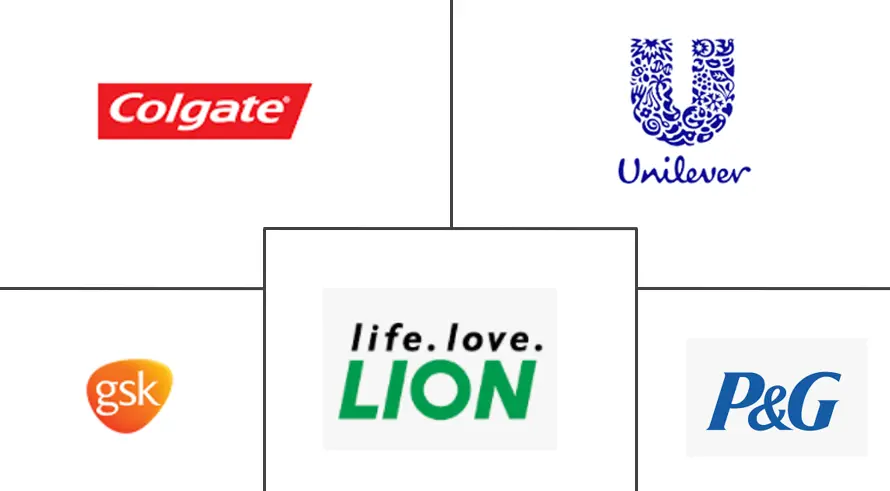Market Size of Asia-Pacific Toothpaste Industry

| Study Period | 2019 - 2029 |
| Base Year For Estimation | 2023 |
| Forecast Data Period | 2024 - 2029 |
| Historical Data Period | 2019 - 2022 |
| CAGR | 7.50 % |
| Market Concentration | Low |
Major Players
*Disclaimer: Major Players sorted in no particular order |
APAC Toothpaste Market Analysis
The Asia-Pacific toothpaste market is projected to grow at a CAGR of 7.50% during the forecast period (2022-2027).
The COVID pandemic has adversely impacted the oral care market in Asia-Pacific. However, it has caused people to pay more attention to their cleanliness, which is an important aspect of oral hygiene. Hand wash and oral care products were the two categories of personal care items that saw the most sales growth in Asia-Pacific during the COVID-19 pandemic. The nationwide lockdowns have, however, caused some inconvenience and constraints in the region's distribution networks.
In the last two decades, there has been a significant shift in the population's food consumption patterns, with a progressive increase in confectionery and junk food consumption. As a result, the population's oral health is harmed, and people seek high-quality toothpaste to combat dental disorders and protect oral health.
The increased concern about oral health among Japan's elderly and youth is fueling the growth of the Japanese toothpaste business. According to GlaxoSmithKline, a worldwide pharmaceutical corporation, the Japanese populace has a high level of dental awareness, making the country a highly valuable market.
APAC Toothpaste Industry Segmentation
Toothpaste is a paste or gel-based oral cleanser applied to teeth with a toothbrush to clean and maintain their appearance and health. The Asia-Pacific Toothpaste market is segmented by Distribution Channel as Supermarkets/ Hypermarkets, Convenience Stores, Pharmacies And Drug Stores, Online, and Others. By Geography, the market is segmented into China, India, Japan, Australia, and Rest of Asia-Pacific. For each segment, the market sizing and forecasts have been done on the basis of value (in USD million).
| By Distribution Channel | |
| Supermarkets/ Hypermarkets | |
| Convenience Stores | |
| Pharmacies and Drug Stores | |
| Online Retail | |
| Other Distribution Channels |
| Geography | |
| China | |
| Japan | |
| India | |
| Australia | |
| Rest of Asia-Pacific |
Asia-Pacific Toothpaste Market Size Summary
The Asia-Pacific toothpaste market is experiencing significant growth, driven by increasing consumer awareness and demand for oral hygiene products. The COVID-19 pandemic, while initially disrupting distribution networks, has heightened awareness of personal cleanliness, boosting sales in the oral care sector. This shift is particularly evident in countries like Japan and China, where there is a growing concern for oral health among various demographics. The rise in confectionery and junk food consumption has led to a greater emphasis on high-quality toothpaste to address dental issues. In Japan, a high level of dental awareness is propelling the toothpaste market, while in China, increased spending on personal care and a preference for organic and herbal products are driving market expansion.
Major players in the industry, such as Colgate-Palmolive, Procter & Gamble, and GlaxoSmithKline, are actively promoting their products through substantial marketing efforts, which are further fueling demand. The market is characterized by innovation, with companies introducing unique products like foaming toothpaste for space use and specialized formulations for specific health needs, such as diabetes. The competitive landscape is dynamic, with key firms expanding their oral care portfolios and launching campaign-based advertisements to enhance consumer engagement. As a result, toothpaste has become an essential component of daily oral hygiene routines in the Asia-Pacific region.
Asia-Pacific Toothpaste Market Size - Table of Contents
-
1. MARKET DYNAMICS
-
1.1 Market Drivers
-
1.2 Market Restraints
-
1.3 Porter's Five Forces Analysis
-
1.3.1 Threat of New Entrants
-
1.3.2 Bargaining Power of Buyers/Consumers
-
1.3.3 Bargaining Power of Suppliers
-
1.3.4 Threat of Substitute Products
-
1.3.5 Intensity of Competitive Rivalry
-
-
-
2. MARKET SEGMENTATION
-
2.1 By Distribution Channel
-
2.1.1 Supermarkets/ Hypermarkets
-
2.1.2 Convenience Stores
-
2.1.3 Pharmacies and Drug Stores
-
2.1.4 Online Retail
-
2.1.5 Other Distribution Channels
-
-
2.2 Geography
-
2.2.1 China
-
2.2.2 Japan
-
2.2.3 India
-
2.2.4 Australia
-
2.2.5 Rest of Asia-Pacific
-
-
Asia-Pacific Toothpaste Market Size FAQs
What is the current Asia-Pacific Toothpaste Market size?
The Asia-Pacific Toothpaste Market is projected to register a CAGR of 7.5% during the forecast period (2024-2029)
Who are the key players in Asia-Pacific Toothpaste Market?
Colgate-Palmolive Company, Unilever, Procter & Gamble, GlaxoSmithKline plc. and Lion Corporation are the major companies operating in the Asia-Pacific Toothpaste Market.

